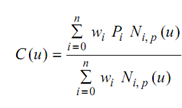Mathematical definitions of NURBS curves:
The mathematical definitions of NURBS curves and surfaces are comparatively simple. A NURBS curve is a vector - valued piecewise rational polynomial function of the form.
 ------------- (1)
------------- (1)
Here wi are the so-called weights, the Pi are the control points (just as in the case of non-rational curves), and Ni, p (u) are the normalized B-spline basis functions of degree p described recursively as
Ni, p (u) = (u - ui / ui + p - ui) Ni, p -1 (u) + (ui + p +1 - u / ui + n +1 - u i +1) Ni +1, p -1 (u) -
 ---------------(2)
---------------(2)
Here ui are the so-called knots forming a knot vector
U = (u0 , u1 , . . . , um ) ----------- (3)
The degree, number of knots, and number of control points are associated by the formula m = n + p + 1. For non-uniform & non-periodic B-splines, the knot vector takes the form
U = (α, α, . . . , u p +1, . . . , um - p -1, β, β, . . . , β) ------------- (4)
where the end knots ? and β are repeated along with multiplicity P + 1. In most of the practical applications ? = 0 and β = 0, as is supposed. The basis function Eq. (2) is explained over the entire line; though, the focus is on the interval [0, 1]. The NURBS CURVE (Eq. (1)) along with the knot vector (Eq. (4)) is a Bezier-like curve. It interpolates the endpoints and is tangential at the endpoints to the first and last legs of the control polygon. Most of the properties of non-rational curves apply to NURBS as well.
NURBS is capable of representing in a single form non-rational B-splines and Bezier curves, in addition to linear and quadric analytic curves, and may be utilized in approximating or interpolators mode. To illustrate the flexibility of the technique, Figure illustrated a number of NURBS curves of order 4 constructed by using the same point set, but with different weighting factors in the homogeneous coordinate system.